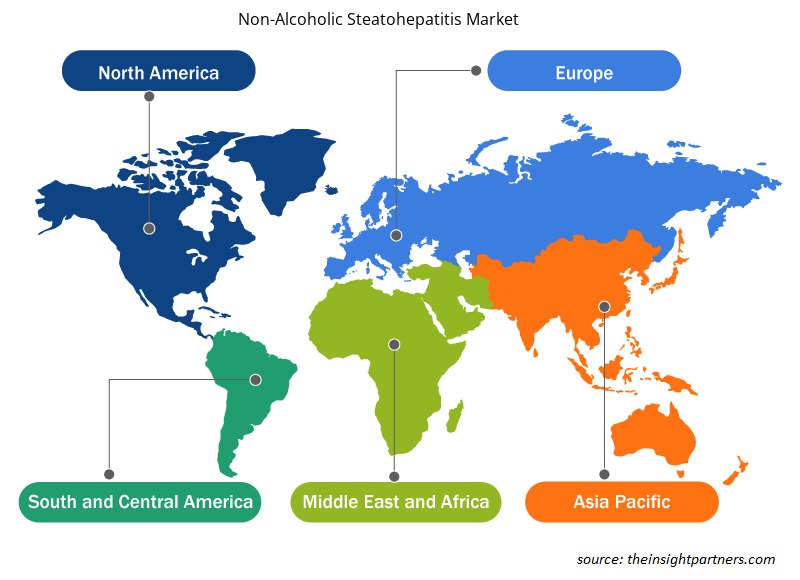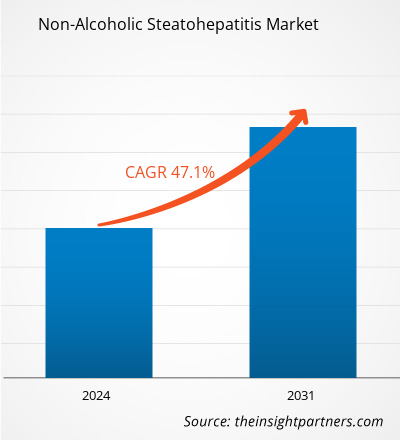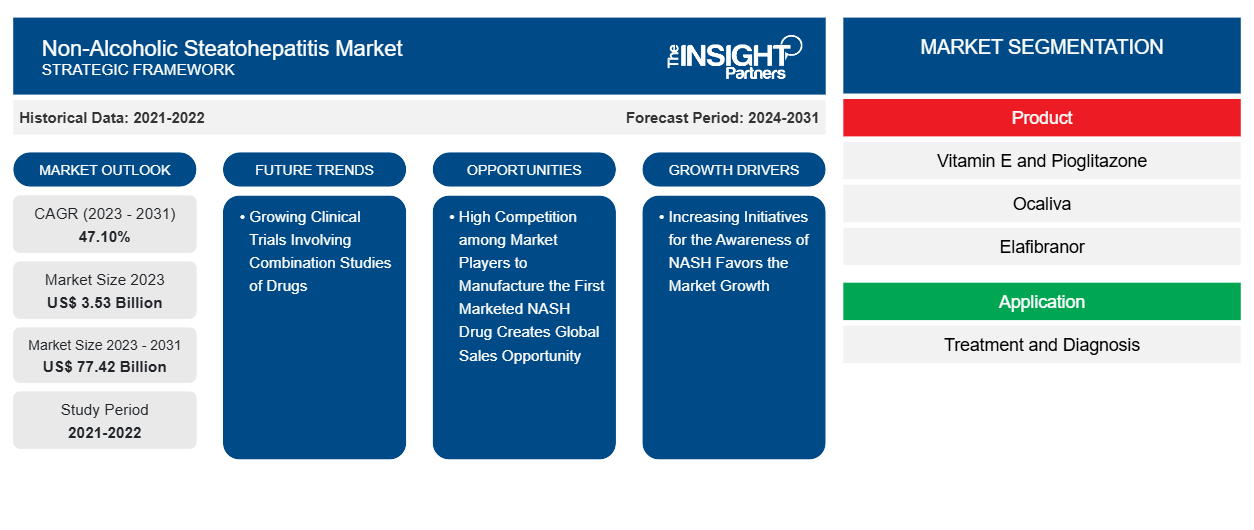Se proyecta que el tamaño del mercado de la esteatohepatitis no alcohólica alcance los 77.420 millones de dólares en 2031, frente a los 3.530 millones de dólares en 2023. Se espera que el mercado registre una CAGR del 47,10 % durante el período 2023-2031. Es probable que los crecientes ensayos clínicos que implican estudios de combinación de fármacos sigan siendo una tendencia clave en el mercado.
Análisis del mercado de la esteatohepatitis no alcohólica
Se espera que la creciente incidencia de los trastornos de la EHNA impulse el mercado de tratamientos para la EHNA a un crecimiento más significativo. Los principales factores que impulsan el crecimiento del mercado son la expansión de la industria de la biotecnología y el aumento del gasto en I+D en el área. En breve, habrá muchas oportunidades lucrativas debido a la creciente adopción del diagnóstico de la EHNA, y se prevé que la región de Asia Pacífico crezca al ritmo más rápido. Las empresas han implementado varias iniciativas, tanto inorgánicas como orgánicas, para apoyar su expansión. Las empresas han estado utilizando varias estrategias orgánicas para expandir sus negocios, como lanzamientos de productos. Las empresas han utilizado tácticas inorgánicas como asociaciones, fusiones y adquisiciones. Por ejemplo, Intercept Pharmaceuticals, Inc. anunció en julio de 2021 que varios resúmenes sobre el uso del ácido obeticólico ( OCA ) para tratar la colangitis biliar primaria ( CBP ) y la esteatohepatitis no alcohólica (NASH) se presentarán en la 56.a Reunión Anual de la Asociación Europea para el Estudio del Hígado ( EASL ), que se llevará a cabo virtualmente del 23 al 26 de junio de 2021.
Descripción general del mercado de la esteatohepatitis no alcohólica
La enfermedad potencialmente mortal conocida como esteatohepatitis no alcohólica (NASH) produce cirrosis hepática grave y cicatrices. La enfermedad hepática crónica más prevalente en todo el mundo es la enfermedad del hígado graso no alcohólico ( NAFLD ). Un tipo progresivo de NAFLD conocido como NASH está tomando cada vez más la delantera en las enfermedades hepáticas terminales y el trasplante de hígado. El Global Liver Institute publicó datos el 12 de junio de 2019, que indican que la esteatohepatitis no alcohólica (NASH) se considera una epidemia. Además, es un tipo de enfermedad del hígado graso no alcohólico ( NAFLD ) que progresa con el tiempo, afectando aproximadamente a 115 millones de personas en la actualidad, con un estimado de 357 millones para 2030. Los factores de riesgo significativos para NAFLD y NASH incluyen obesidad, diabetes tipo 2 e hiperlipidemia ; más del 70% de la población es obesa, el 75% tiene diabetes tipo 2 y el 20-80% tiene hiperlipidemia . Si la EHNA no se trata, puede provocar cáncer de hígado, cirrosis y la necesidad de un trasplante de hígado.
La EHGNA /NASH es cada vez más frecuente, pero sigue siendo una enfermedad poco diagnosticada y, para prevenir su progresión y las consecuencias que conlleva, es necesario detectarla de forma temprana. Por lo tanto, se prevé que la creciente prevalencia de la EHNA impulsará el mercado de la esteatohepatitis no alcohólica (EHNA).
Personalice este informe según sus necesidades
Obtendrá personalización en cualquier informe, sin cargo, incluidas partes de este informe o análisis a nivel de país, paquete de datos de Excel, así como también grandes ofertas y descuentos para empresas emergentes y universidades.
-
Obtenga las principales tendencias clave del mercado de este informe.Esta muestra GRATUITA incluirá análisis de datos, desde tendencias del mercado hasta estimaciones y pronósticos.
Factores impulsores y oportunidades del mercado de la esteatohepatitis no alcohólica
Aumentar las iniciativas de concientización sobre la EHNA favorece el crecimiento del mercado
La EHNA es una enfermedad que no se comprende bien. Una vía de derivación sistemática y la detección temprana de esta enfermedad dependen de la sensibilización del público y de los médicos de atención primaria (PCP) sobre ella. El grupo de pacientes se puede aumentar identificando a más personas y enviándolas a especialistas para una evaluación adicional mediante la creación de una vía clara para derivaciones de pacientes y campañas de sensibilización de los pacientes. El 12 de junio de 2018, "Día Internacional de la EHNA", el Programa de Educación sobre la EHNA lanzó una campaña de educación pública para aumentar el conocimiento público sobre la enfermedad del hígado graso no alcohólico ( NAFLD ), que afecta a más de 115 millones de personas, y su forma más avanzada, la EHNA.
On June 12, 2019, International NASH Day, NASH 24X7, a digital platform dedicated to increasing exposure and awareness regarding the NASH epidemic, took a few actions, including HCP support patient awareness. NASH Crusaders of NASH 24X7 teamed up with leading HCPs (gastroenterologists and hepatologists) throughout India to spread awareness on International NASH Day. Regarding patient education, the NASH Crusaders of NASH 24X7 worked with healthcare professionals all over India to organize numerous small- and large-scale awareness- and education-raising workshops on liver health and the importance of leading a healthy lifestyle to prevent NAFLD/NASH. Several initiatives were launched to reach the general public on International NASH Day, including press releases and television programs that used print and digital media.
For International NASH Day on June 12, 2020, the American Liver Foundation joined a global community to raise awareness about NASH with support from the Allergan Foundation. American Liver Foundation (ALF) is now piloting a NASH Text Messaging Program, wherein people can sign up to receive three weekly messages for ten weeks. Messages include hyperlinks to NASH resources, facts, interactive quizzes, and sensible pointers for everyday self-management. ALF will open this system to the general public when the pilot is finished and evaluated. It collaborated with the Global Liver Institute (GLI) for International NASH Day and shared a few social media posts with links to GLI posts and the International NASH Day page.
Thus, rising initiatives for the awareness of NASH are driving the non-alcoholic steatohepatitis (NASH) market.
High Competition among Market Players to Manufacture the First Marketed NASH Drug Creates Global Sales Opportunity
According to Back Bay Life Science Advisors, at its peak, the global NASH market is anticipated to hit an average of USD 13 billion yearly by 2030. As of June 2020, the NASH pipeline of first-wave drugs holds 54 medical candidates in development by 47 companies evaluating 29 unique mechanisms of action. Over the last decades, the NASH pipeline witnessed many late-degree programs fail to reveal clinical efficacy after focusing on a broad range of mechanisms of action. Competition to manufacture the first marketed NASH drug stays high among market players, with numerous late-stage candidates vying for opportunities to launch the first marketed NASH drug. Below are a few companies in drug development's 3rd and 2nd phases. Market players are racing to be the first ones to launch drugs in the market, creating a more significant opportunity to generate sales in the global market.
Análisis de segmentación del informe de mercado de esteatohepatitis no alcohólica
Los segmentos clave que contribuyeron a la derivación del análisis del mercado de esteatohepatitis no alcohólica son el producto, la aplicación y el canal de ventas.
- Según el producto, el mercado de la esteatohepatitis no alcohólica se segmenta en vitamina E y pioglitazona, elafibranor, ocaliva, selonsertib y cenicriviroc, entre otros. El otro segmento tuvo la participación de mercado más significativa en 2023.
- Por aplicación, el mercado se divide en tratamiento y diagnóstico. El segmento de tratamiento tuvo la mayor participación del mercado en 2023.
- Por canal de venta, el mercado está segmentado en farmacias hospitalarias, proveedores en línea y farmacias minoristas. El segmento de farmacias minoristas tuvo la mayor participación del mercado en 2023.
Análisis de la cuota de mercado de la esteatohepatitis no alcohólica por geografía
El alcance geográfico del informe de mercado de esteatohepatitis no alcohólica se divide principalmente en cinco regiones: América del Norte, Asia Pacífico, Europa, Medio Oriente y África, y América del Sur y Central.
América del Norte está formada por tres países: Estados Unidos, Canadá y México. Estados Unidos es el mayor mercado de esteatohepatitis no alcohólica, seguido de Canadá y México. Se espera que el mercado de esteatohepatitis no alcohólica crezca a un ritmo más rápido debido al aumento de las actividades de investigación y desarrollo y la mayor adopción de avances tecnológicos. Las grandes organizaciones de atención médica y la creciente prevalencia de la esteatohepatitis no alcohólica también impulsan el crecimiento del mercado en esta área. La grasa del sobrepeso se acumula en el hígado en una afección conocida como enfermedad del hígado graso no alcohólico (NAFLD). El consumo excesivo de alcohol no es la causa de esta acumulación de grasa. La enfermedad hepática asociada al alcohol es el término para una afección en la que la acumulación de grasa en el hígado es provocada por el consumo excesivo de alcohol. El hígado graso no alcohólico (NAFL) y la esteatohepatitis no alcohólica (NASH) son las dos formas de NAFLD. En los EE. UU., NAFLD es una de las causas más frecuentes de enfermedad hepática. NAFL está presente en la mayoría de los pacientes con NAFLD. La EHNA solo está presente en un pequeño porcentaje de pacientes con EHNA. Según los expertos, entre el 1,5 % y el 6,5 % de los adultos estadounidenses tienen EHNA y aproximadamente el 24 % de los adultos estadounidenses tienen EHNA.
La esteatohepatitis no alcohólica (NASH, por sus siglas en inglés) se caracteriza por la acumulación de grasa, la inflamación y el daño celular; también puede provocar cirrosis y carcinoma hepatocelular. Según un estudio de prevalencia en EE. UU., en 2016 hubo 17,3 millones de casos de esteatohepatitis no alcohólica (NASH, por sus siglas en inglés) y 85,3 millones de casos de EHGNA en EE. UU. Debido a estas afecciones, los gastos de atención médica del país ascienden a miles de millones de dólares. Además, la EHGNA es un factor de riesgo de enfermedad cardiovascular por sí sola. Como resultado, la EHGNA y la esteatohepatitis no alcohólica (NASH, por sus siglas en inglés) se están convirtiendo en estados patológicos cada vez más esenciales que los aseguradores deben supervisar.
Perspectivas regionales del mercado de la esteatohepatitis no alcohólica
Los analistas de Insight Partners explicaron en detalle las tendencias y los factores regionales que influyen en el mercado de la esteatohepatitis no alcohólica durante el período de pronóstico. Esta sección también analiza los segmentos y la geografía del mercado de la esteatohepatitis no alcohólica en América del Norte, Europa, Asia Pacífico, Oriente Medio y África, y América del Sur y Central.Steatohepatitis Market throughout the forecast period have been thoroughly explained by the analysts at Insight Partners. This section also discusses Non-Alcoholic Steatohepatitis Market segments and geography across North America, Europe, Asia Pacific, Middle East and Africa, and South and Central America.

- Obtenga datos regionales específicos para el mercado de esteatohepatitis no alcohólica
Alcance del informe de mercado sobre esteatohepatitis no alcohólica
| Atributo del informe | Detalles |
|---|---|
| Tamaño del mercado en 2023 | 3.530 millones de dólares estadounidenses |
| Tamaño del mercado en 2031 | US$ 77,42 mil millones |
| CAGR global (2023 - 2031) | 47,10% |
| Datos históricos | 2021-2022 |
| Período de pronóstico | 2024-2031 |
| Segmentos cubiertos |
Por producto
|
| Regiones y países cubiertos |
América del norte
|
| Líderes del mercado y perfiles de empresas clave |
|
Densidad de actores del mercado de la esteatohepatitis no alcohólica: comprensión de su impacto en la dinámica empresarial
El mercado de la esteatohepatitis no alcohólica está creciendo rápidamente, impulsado por la creciente demanda de los usuarios finales debido a factores como la evolución de las preferencias de los consumidores, los avances tecnológicos y una mayor conciencia de los beneficios del producto. A medida que aumenta la demanda, las empresas amplían sus ofertas, innovan para satisfacer las necesidades de los consumidores y aprovechan las tendencias emergentes, lo que impulsa aún más el crecimiento del mercado.
La densidad de actores del mercado se refiere a la distribución de las empresas o firmas que operan dentro de un mercado o industria en particular. Indica cuántos competidores (actores del mercado) están presentes en un espacio de mercado determinado en relación con su tamaño o valor total de mercado.
Las principales empresas que operan en el mercado de la esteatohepatitis no alcohólica son:
- Genfit SA
- One Way Hígado, SL
- SAS BioPredictivo
- Compañía farmacéutica Cadila Ltd.
- Laboratorios Prometeo
- Siemens Healthineers AG
Descargo de responsabilidad : Las empresas enumeradas anteriormente no están clasificadas en ningún orden particular.

- Obtenga una descripción general de los principales actores clave del mercado de esteatohepatitis no alcohólica
Noticias y desarrollos recientes del mercado de la esteatohepatitis no alcohólica
El mercado de la esteatohepatitis no alcohólica se evalúa mediante la recopilación de datos cualitativos y cuantitativos posteriores a la investigación primaria y secundaria, que incluye publicaciones corporativas importantes, datos de asociaciones y bases de datos. A continuación, se enumeran algunos de los desarrollos en el mercado de la esteatohepatitis no alcohólica:
- Novartis anunció que había firmado un acuerdo con Carisma Therapeutic para fabricar la terapia celular CAR-M dirigida a HER 2, probada en ensayos iniciales para tratar tumores sólidos. (Fuente: Novartis AG, comunicado de prensa, marzo de 2022)Carisma Therapeutic to manufacture the HER 2 targeted CAR-M cell therapy, tested in initial trials to treat solid tumors. (Source: Novartis AG, Press Release, March 2022)
- Siemens Healthineers anunció el lanzamiento de la prueba Enhanced Liver Fibrosis (ELF) en EE. UU. Esta es la primera vez que la prueba está disponible comercialmente en EE. UU., luego de la autorización de comercialización de novo de la Administración de Alimentos y Medicamentos de EE. UU. (FDA) en agosto de 2021. (Fuente: Siemens Healthineers AG, comunicado de prensa, enero de 2022)Healthineers announced the launch of the Enhanced Liver Fibrosis (ELF) Test in US. This is the first time the test is commercially available in the U.S., following De Novo marketing authorization from the U.S. Food and Drug Administration (FDA) in August 2021. (Source: Siemens Healthineers AG, Press Release, January 2022)
Informe de mercado sobre esteatohepatitis no alcohólica: cobertura y resultadosSteatohepatitis Market Report Coverage and Deliverables
El informe “Tamaño y pronóstico del mercado de esteatohepatitis no alcohólica (2021-2031)” proporciona un análisis detallado del mercado que cubre las siguientes áreas:Steatohepatitis Market Size and Forecast (2021–2031)” report provides a detailed analysis of the market covering below areas:
- Tamaño del mercado de esteatohepatitis no alcohólica y pronóstico a nivel mundial, regional y nacional para todos los segmentos clave del mercado cubiertos bajo el alcancesteatohepatitis market size and forecast at global, regional, and country levels for all the key market segments covered under the scope
- Tendencias del mercado de la esteatohepatitis no alcohólica, así como dinámica del mercado, como impulsores, restricciones y oportunidades clavesteatohepatitis market trends as well as market dynamics such as drivers, restraints, and key opportunities
- Análisis detallado de las cinco fuerzas de Porter y PEST y FODA
- Análisis del mercado de esteatohepatitis no alcohólica que cubre las tendencias clave del mercado, el marco global y regional, los principales actores, las regulaciones y los desarrollos recientes del mercado.steatohepatitis market analysis covering key market trends, global and regional framework, major players, regulations, and recent market developments.
- Análisis del panorama de la industria y de la competencia que abarca la concentración del mercado, el análisis de mapas de calor, los actores destacados y los desarrollos recientes del mercado de la esteatohepatitis no alcohólicasteatohepatitis market
- Perfiles detallados de empresas
- Análisis histórico (2 años), año base, pronóstico (7 años) con CAGR
- Análisis PEST y FODA
- Tamaño del mercado, valor/volumen: global, regional y nacional
- Industria y panorama competitivo
- Conjunto de datos de Excel
Informes recientes
Informes relacionados
Testimonios
Razón para comprar
- Toma de decisiones informada
- Comprensión de la dinámica del mercado
- Análisis competitivo
- Información sobre clientes
- Pronósticos del mercado
- Mitigación de riesgos
- Planificación estratégica
- Justificación de la inversión
- Identificación de mercados emergentes
- Mejora de las estrategias de marketing
- Impulso de la eficiencia operativa
- Alineación con las tendencias regulatorias























 Obtenga una muestra gratuita para - Mercado de la esteatohepatitis no alcohólica
Obtenga una muestra gratuita para - Mercado de la esteatohepatitis no alcohólica